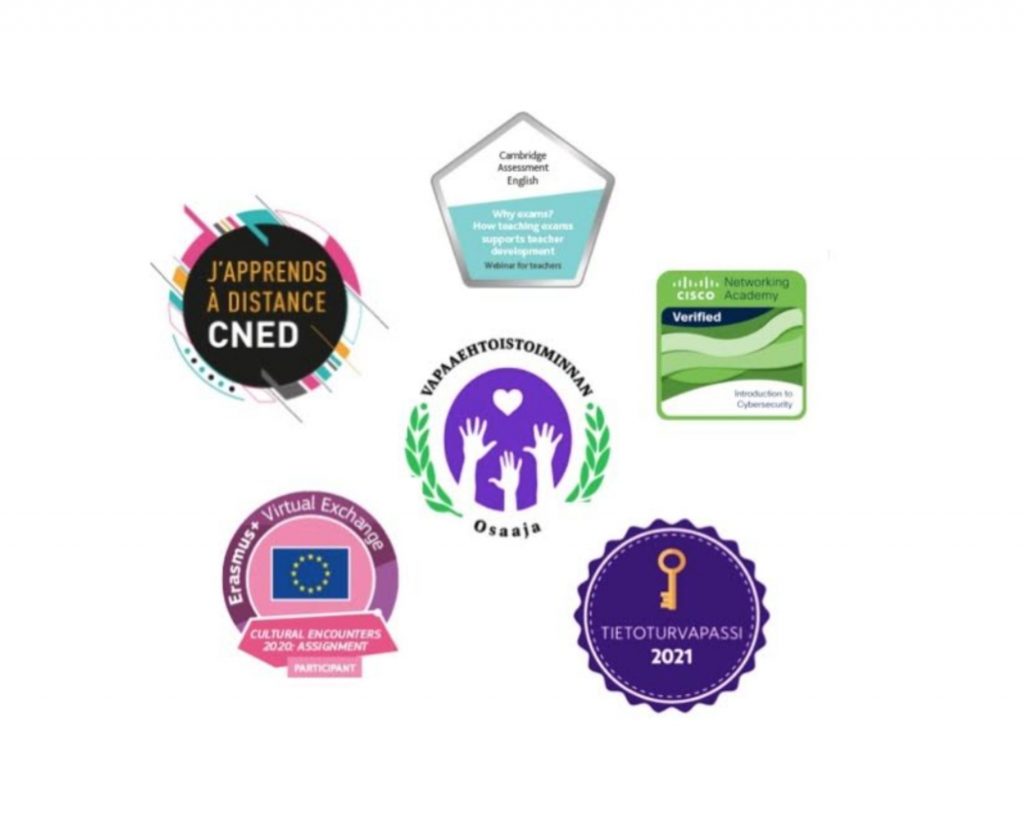About Open Badges
What is an Open Badge?
Open Badges are created and issued to recognise competencies, skills, achievements or attitudes of their recipients. From a technical point of view, an Open Badge is a digital picture, which contains metadata that informs who has issued the badge to whom and on what basis. However, an Open Badge is more than a digital image. It is a standard and verifiable digital credential whose metadata aligns with the Open Badge standard created by the Mozilla Foundation and further developed by 1EdTech. To create a standard Open Badge, you don’t need to know about the standard’s technical specifications. Instead, you can use the Open Badge Factory platform or another standard-compliant Open Badge platform. However, if you want to learn a bit more about the open standard technology, read the next paragraph.


What does an Open Badge contain?
Explanations about badges are sometimes a bit technical, and users can get confused when they hear specialists speaking about badge classes and badge assertions. To simplify, let’s say that a badge class is information written by the badge creator. It is a kind of a template used to generate (bake) the content of the badge. A badge assertion can be defined as the badge received by a recipient. A badge assertion is unique, it carries information about the badge issuer and the badge holder, and it has an URL (assertion URL) used to validate the badge.
To clarify, a badge class contains the name of the badge, a description, and a criteria page. The description field is the place where badge creators write descriptions of their badges. The criteria page, which is “the heart of the badge”, is where badge issuers present the criteria used to recognise the skills, achievements or competences of their badges’ recipients.
Why have Open Badges been invented?
Originally Open Badges were invented by the Mozilla Foundation to recognise and make visible all the things we learn in our everyday life that our formal recognition systems (certificates and diplomas) frequently fail to recognise. Badges are often related to non-formal and informal learning contexts; they are seen as a way to recognise what we learn at work, in our hobbies or engagements and as a way to support lifelong learning, employability and social integration.
From a more general perspective, the Open Badges movement promotes the idea that for achieving a better recognition of the things we learn and achieve in our everyday lives (which is more than 70% of our knowledge capital), recognition should be open. In other words, everyone (organisations, communities and individuals) should be able to recognise and to be recognised.


Who issues Open Badges?
The Open Badge concept was invented 10 years ago: The first organisations issuing open badges were different kinds of associations and NGOs (social, humanitarian, professional) and educational institutions such as universities and professional schools. A few years later, training companies and some corporates started issuing badges. Open Badge Factory’s statistics show that 40% of its customers are associations and NGOs, 40% are educational institutions and 20% companies. Recently the number of companies using OBF has been rising.
How are Open Badges used?
It is impossible to give an exhaustive list of use cases because the way badges are used depends on the contexts where they are created and issued. From a general point of view, badges are about recognition but there are different shades of recognition. In some formal contexts, recognition can be understood as an organisation centric and authority based validation of achievements, and in this case, badges are usually used as digital certificates. In less formal or informal contexts, recognition can be understood as an open recognition and badges can be seen as learner-centric self-claimed badges or micro-portfolios endorsed by peers and communities. Many organisations can use badges simultaneously in formal and less formal ways. For example, many universities issue digital badges for certification but also for recognising volunteer work, and other less formal skills and engagements.


Finally, to give a general answer to the question, let’s say that open badges are often used for recognising both formal and informal skills and achievements but also for motivating their holders. Some companies issue badges for improving their staff engagement, and some associations to support social integration. Badges do not have to be rewarded for closing a process. They can also be used to build and to make visible pathways, to set up goals, to support professional development or to fight school drop out. It is also interesting that highly networked organisations such as large international NGOs use open badges in their training activities as a solution to support quality assurance.
To learn more about our customers’ use cases, please visit OBF Academy.
More information about Open Badges:
